HRD Report: Analyzing Training Needs at Different Management Levels
VerifiedAdded on 2020/07/22
|18
|4952
|41
Report
AI Summary
This report provides a comprehensive analysis of Human Resource Development (HRD) within an organizational context, specifically using HSBC as a case study. It begins by exploring various learning styles and their implications for designing effective induction training programs. The report then delves into the significance of the learning curve and the transfer of learning within an organizational environment. Furthermore, it assesses how learning theories and styles contribute to the development of training programs, comparing the training needs of managerial staff at different levels. The advantages and disadvantages of various training methods are also evaluated, followed by the application of a systematic approach to planning training and development programs. The report concludes with an evaluation of induction training programs, the effectiveness of training events, and the review of evaluation methods, including an analysis of the government's role in training and development and the impact of contemporary skills assessments.

Paraphrase This Document
Need a fresh take? Get an instant paraphrase of this document with our AI Paraphraser
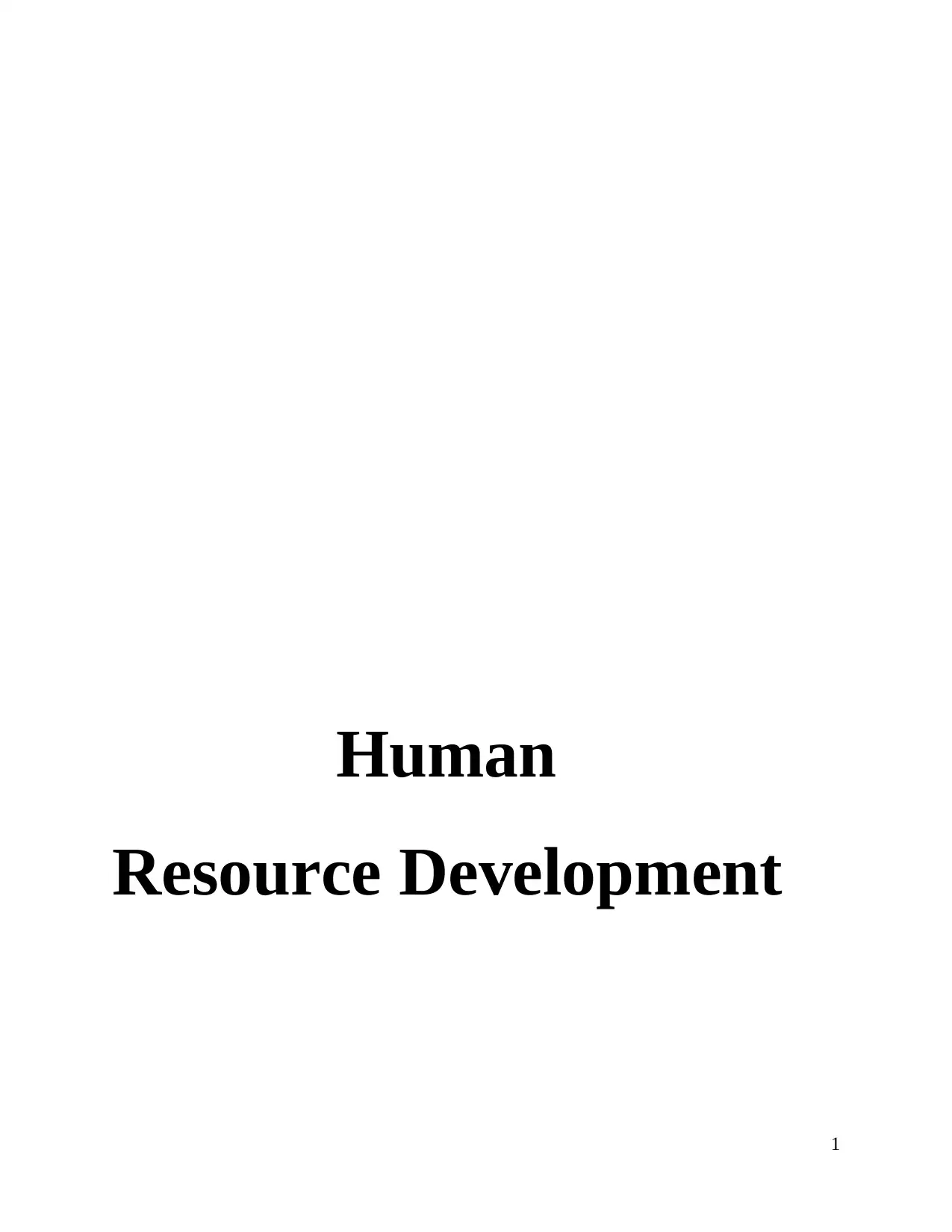
Human
Resource Development
1
Resource Development
1
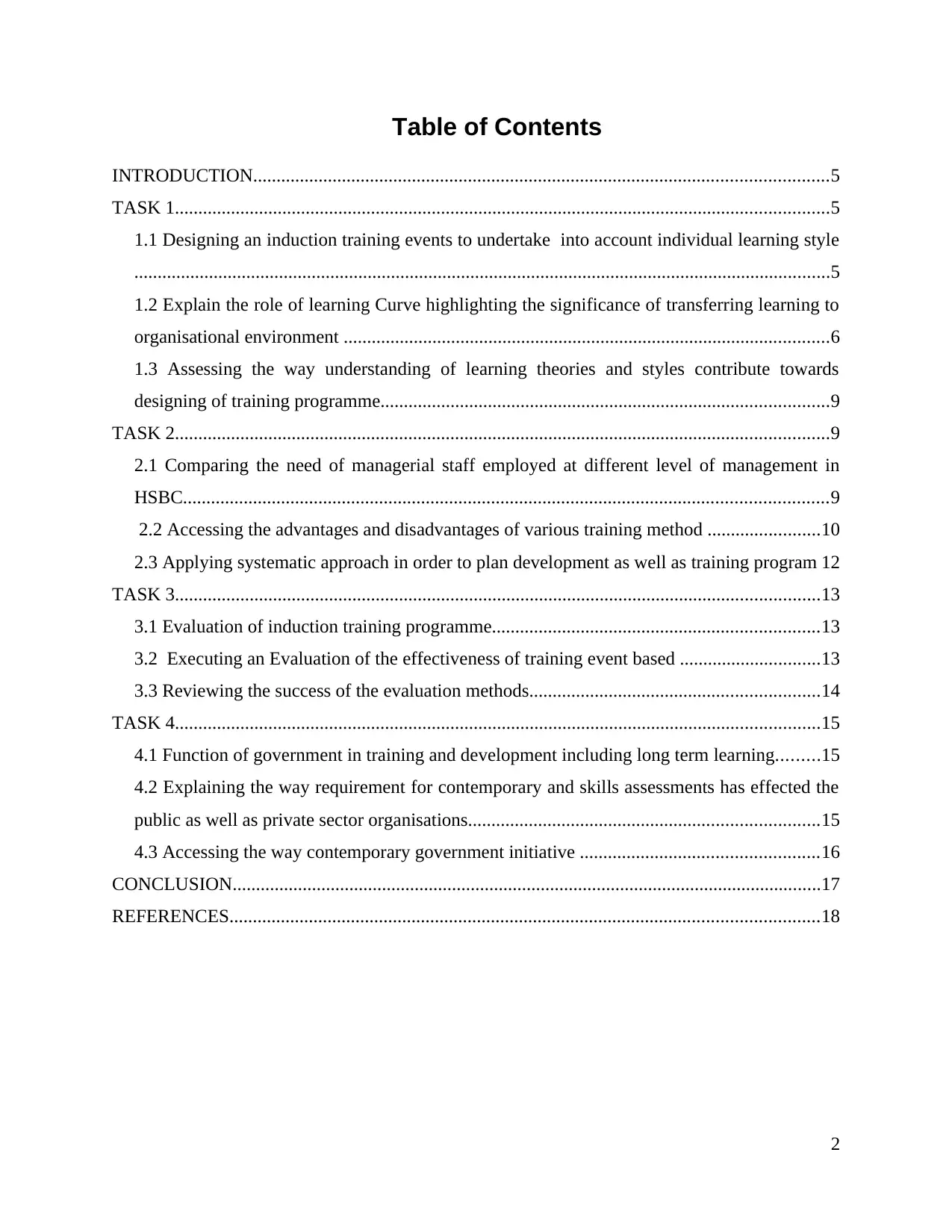
Table of Contents
INTRODUCTION...........................................................................................................................5
TASK 1............................................................................................................................................5
1.1 Designing an induction training events to undertake into account individual learning style
.....................................................................................................................................................5
1.2 Explain the role of learning Curve highlighting the significance of transferring learning to
organisational environment ........................................................................................................6
1.3 Assessing the way understanding of learning theories and styles contribute towards
designing of training programme................................................................................................9
TASK 2............................................................................................................................................9
2.1 Comparing the need of managerial staff employed at different level of management in
HSBC..........................................................................................................................................9
2.2 Accessing the advantages and disadvantages of various training method ........................10
2.3 Applying systematic approach in order to plan development as well as training program 12
TASK 3..........................................................................................................................................13
3.1 Evaluation of induction training programme......................................................................13
3.2 Executing an Evaluation of the effectiveness of training event based ..............................13
3.3 Reviewing the success of the evaluation methods..............................................................14
TASK 4..........................................................................................................................................15
4.1 Function of government in training and development including long term learning.........15
4.2 Explaining the way requirement for contemporary and skills assessments has effected the
public as well as private sector organisations...........................................................................15
4.3 Accessing the way contemporary government initiative ...................................................16
CONCLUSION..............................................................................................................................17
REFERENCES..............................................................................................................................18
2
INTRODUCTION...........................................................................................................................5
TASK 1............................................................................................................................................5
1.1 Designing an induction training events to undertake into account individual learning style
.....................................................................................................................................................5
1.2 Explain the role of learning Curve highlighting the significance of transferring learning to
organisational environment ........................................................................................................6
1.3 Assessing the way understanding of learning theories and styles contribute towards
designing of training programme................................................................................................9
TASK 2............................................................................................................................................9
2.1 Comparing the need of managerial staff employed at different level of management in
HSBC..........................................................................................................................................9
2.2 Accessing the advantages and disadvantages of various training method ........................10
2.3 Applying systematic approach in order to plan development as well as training program 12
TASK 3..........................................................................................................................................13
3.1 Evaluation of induction training programme......................................................................13
3.2 Executing an Evaluation of the effectiveness of training event based ..............................13
3.3 Reviewing the success of the evaluation methods..............................................................14
TASK 4..........................................................................................................................................15
4.1 Function of government in training and development including long term learning.........15
4.2 Explaining the way requirement for contemporary and skills assessments has effected the
public as well as private sector organisations...........................................................................15
4.3 Accessing the way contemporary government initiative ...................................................16
CONCLUSION..............................................................................................................................17
REFERENCES..............................................................................................................................18
2
⊘ This is a preview!⊘
Do you want full access?
Subscribe today to unlock all pages.

Trusted by 1+ million students worldwide
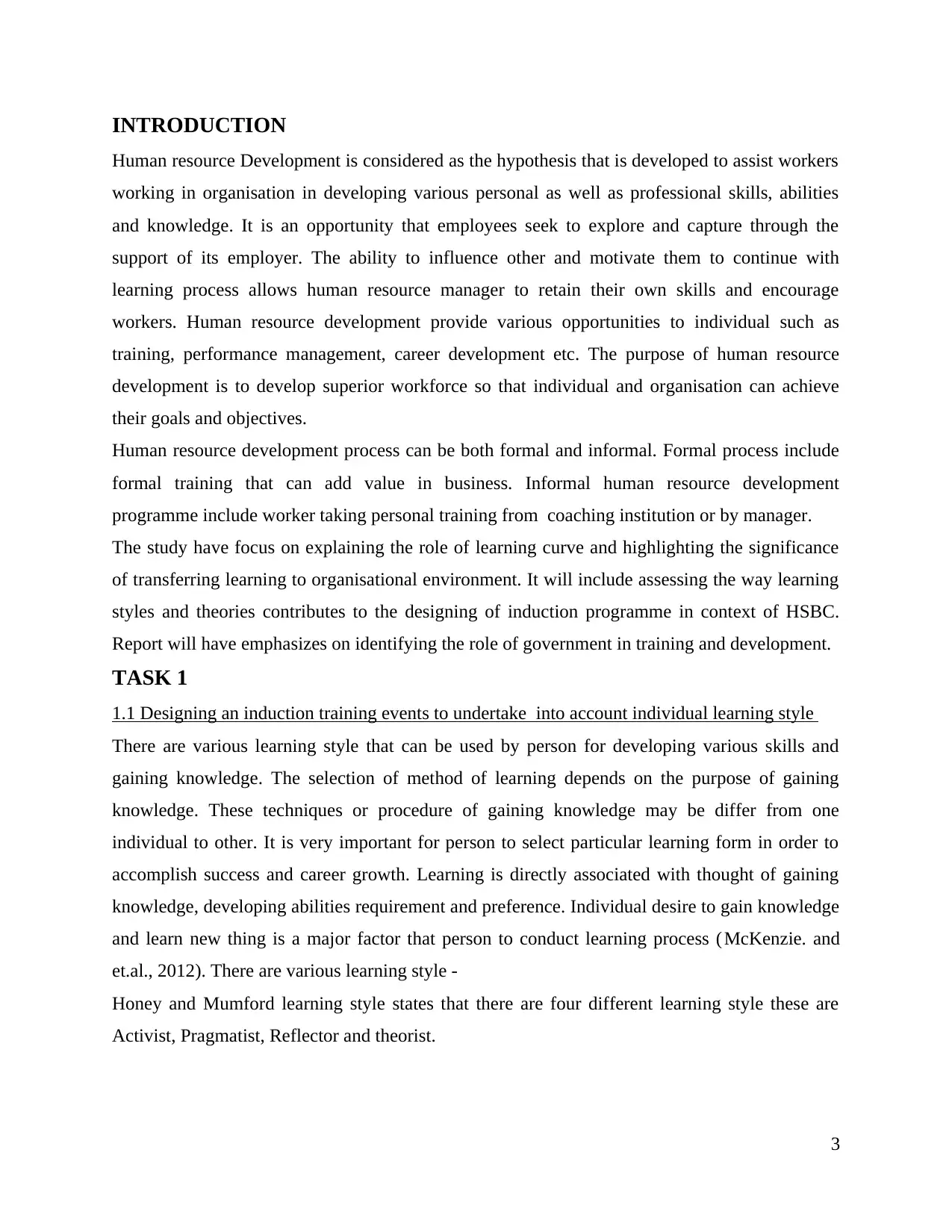
INTRODUCTION
Human resource Development is considered as the hypothesis that is developed to assist workers
working in organisation in developing various personal as well as professional skills, abilities
and knowledge. It is an opportunity that employees seek to explore and capture through the
support of its employer. The ability to influence other and motivate them to continue with
learning process allows human resource manager to retain their own skills and encourage
workers. Human resource development provide various opportunities to individual such as
training, performance management, career development etc. The purpose of human resource
development is to develop superior workforce so that individual and organisation can achieve
their goals and objectives.
Human resource development process can be both formal and informal. Formal process include
formal training that can add value in business. Informal human resource development
programme include worker taking personal training from coaching institution or by manager.
The study have focus on explaining the role of learning curve and highlighting the significance
of transferring learning to organisational environment. It will include assessing the way learning
styles and theories contributes to the designing of induction programme in context of HSBC.
Report will have emphasizes on identifying the role of government in training and development.
TASK 1
1.1 Designing an induction training events to undertake into account individual learning style
There are various learning style that can be used by person for developing various skills and
gaining knowledge. The selection of method of learning depends on the purpose of gaining
knowledge. These techniques or procedure of gaining knowledge may be differ from one
individual to other. It is very important for person to select particular learning form in order to
accomplish success and career growth. Learning is directly associated with thought of gaining
knowledge, developing abilities requirement and preference. Individual desire to gain knowledge
and learn new thing is a major factor that person to conduct learning process ( McKenzie. and
et.al., 2012). There are various learning style -
Honey and Mumford learning style states that there are four different learning style these are
Activist, Pragmatist, Reflector and theorist.
3
Human resource Development is considered as the hypothesis that is developed to assist workers
working in organisation in developing various personal as well as professional skills, abilities
and knowledge. It is an opportunity that employees seek to explore and capture through the
support of its employer. The ability to influence other and motivate them to continue with
learning process allows human resource manager to retain their own skills and encourage
workers. Human resource development provide various opportunities to individual such as
training, performance management, career development etc. The purpose of human resource
development is to develop superior workforce so that individual and organisation can achieve
their goals and objectives.
Human resource development process can be both formal and informal. Formal process include
formal training that can add value in business. Informal human resource development
programme include worker taking personal training from coaching institution or by manager.
The study have focus on explaining the role of learning curve and highlighting the significance
of transferring learning to organisational environment. It will include assessing the way learning
styles and theories contributes to the designing of induction programme in context of HSBC.
Report will have emphasizes on identifying the role of government in training and development.
TASK 1
1.1 Designing an induction training events to undertake into account individual learning style
There are various learning style that can be used by person for developing various skills and
gaining knowledge. The selection of method of learning depends on the purpose of gaining
knowledge. These techniques or procedure of gaining knowledge may be differ from one
individual to other. It is very important for person to select particular learning form in order to
accomplish success and career growth. Learning is directly associated with thought of gaining
knowledge, developing abilities requirement and preference. Individual desire to gain knowledge
and learn new thing is a major factor that person to conduct learning process ( McKenzie. and
et.al., 2012). There are various learning style -
Honey and Mumford learning style states that there are four different learning style these are
Activist, Pragmatist, Reflector and theorist.
3
Paraphrase This Document
Need a fresh take? Get an instant paraphrase of this document with our AI Paraphraser
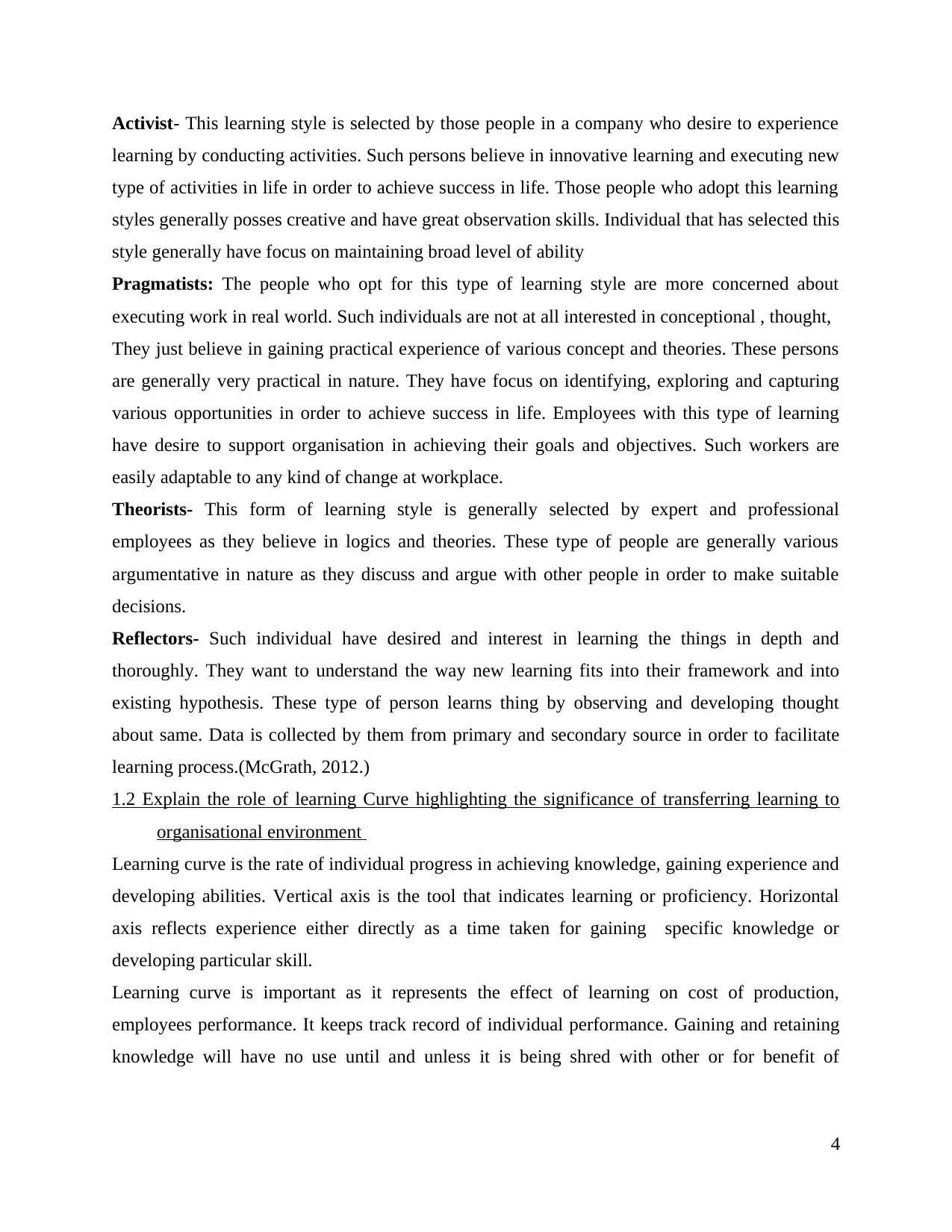
Activist- This learning style is selected by those people in a company who desire to experience
learning by conducting activities. Such persons believe in innovative learning and executing new
type of activities in life in order to achieve success in life. Those people who adopt this learning
styles generally posses creative and have great observation skills. Individual that has selected this
style generally have focus on maintaining broad level of ability
Pragmatists: The people who opt for this type of learning style are more concerned about
executing work in real world. Such individuals are not at all interested in conceptional , thought,
They just believe in gaining practical experience of various concept and theories. These persons
are generally very practical in nature. They have focus on identifying, exploring and capturing
various opportunities in order to achieve success in life. Employees with this type of learning
have desire to support organisation in achieving their goals and objectives. Such workers are
easily adaptable to any kind of change at workplace.
Theorists- This form of learning style is generally selected by expert and professional
employees as they believe in logics and theories. These type of people are generally various
argumentative in nature as they discuss and argue with other people in order to make suitable
decisions.
Reflectors- Such individual have desired and interest in learning the things in depth and
thoroughly. They want to understand the way new learning fits into their framework and into
existing hypothesis. These type of person learns thing by observing and developing thought
about same. Data is collected by them from primary and secondary source in order to facilitate
learning process.(McGrath, 2012.)
1.2 Explain the role of learning Curve highlighting the significance of transferring learning to
organisational environment
Learning curve is the rate of individual progress in achieving knowledge, gaining experience and
developing abilities. Vertical axis is the tool that indicates learning or proficiency. Horizontal
axis reflects experience either directly as a time taken for gaining specific knowledge or
developing particular skill.
Learning curve is important as it represents the effect of learning on cost of production,
employees performance. It keeps track record of individual performance. Gaining and retaining
knowledge will have no use until and unless it is being shred with other or for benefit of
4
learning by conducting activities. Such persons believe in innovative learning and executing new
type of activities in life in order to achieve success in life. Those people who adopt this learning
styles generally posses creative and have great observation skills. Individual that has selected this
style generally have focus on maintaining broad level of ability
Pragmatists: The people who opt for this type of learning style are more concerned about
executing work in real world. Such individuals are not at all interested in conceptional , thought,
They just believe in gaining practical experience of various concept and theories. These persons
are generally very practical in nature. They have focus on identifying, exploring and capturing
various opportunities in order to achieve success in life. Employees with this type of learning
have desire to support organisation in achieving their goals and objectives. Such workers are
easily adaptable to any kind of change at workplace.
Theorists- This form of learning style is generally selected by expert and professional
employees as they believe in logics and theories. These type of people are generally various
argumentative in nature as they discuss and argue with other people in order to make suitable
decisions.
Reflectors- Such individual have desired and interest in learning the things in depth and
thoroughly. They want to understand the way new learning fits into their framework and into
existing hypothesis. These type of person learns thing by observing and developing thought
about same. Data is collected by them from primary and secondary source in order to facilitate
learning process.(McGrath, 2012.)
1.2 Explain the role of learning Curve highlighting the significance of transferring learning to
organisational environment
Learning curve is the rate of individual progress in achieving knowledge, gaining experience and
developing abilities. Vertical axis is the tool that indicates learning or proficiency. Horizontal
axis reflects experience either directly as a time taken for gaining specific knowledge or
developing particular skill.
Learning curve is important as it represents the effect of learning on cost of production,
employees performance. It keeps track record of individual performance. Gaining and retaining
knowledge will have no use until and unless it is being shred with other or for benefit of
4
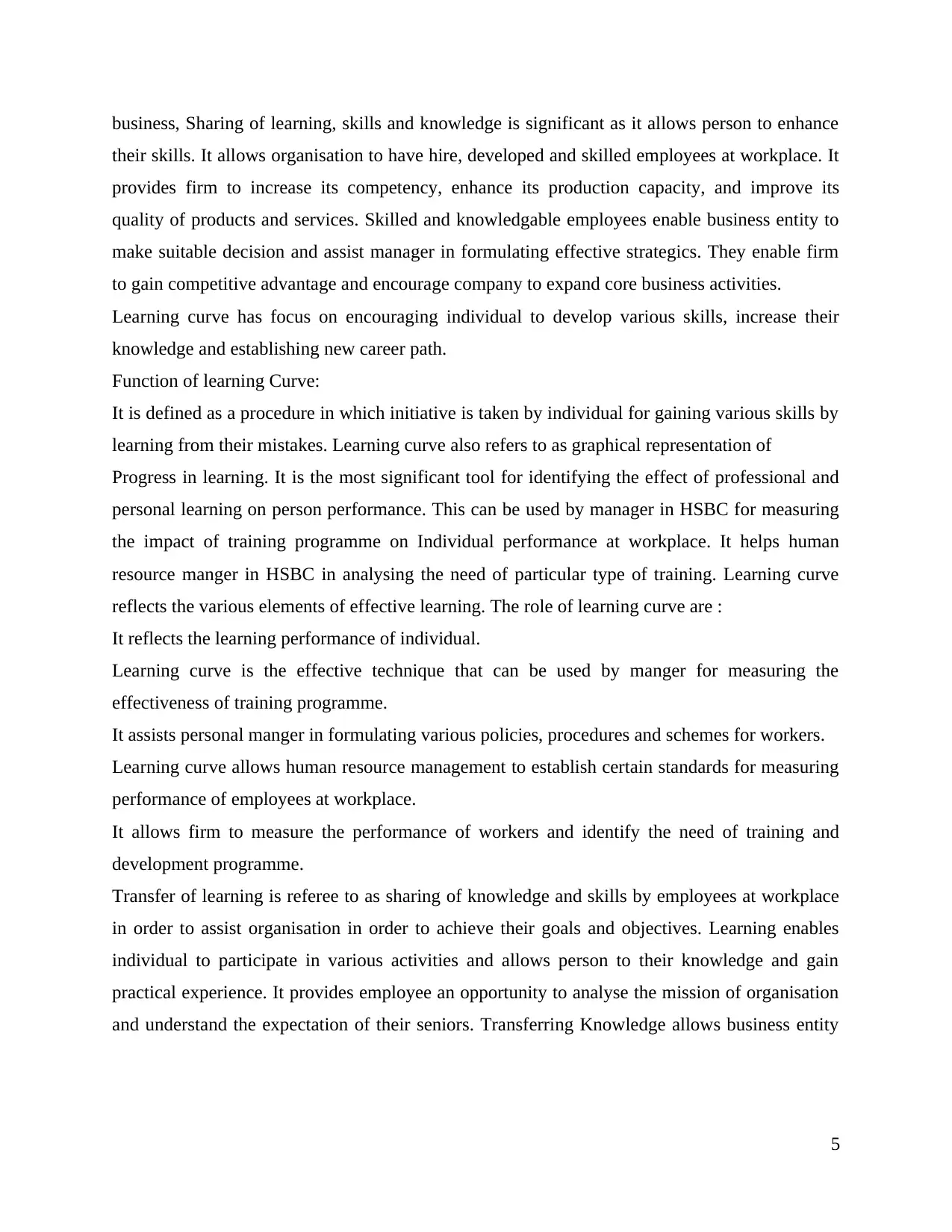
business, Sharing of learning, skills and knowledge is significant as it allows person to enhance
their skills. It allows organisation to have hire, developed and skilled employees at workplace. It
provides firm to increase its competency, enhance its production capacity, and improve its
quality of products and services. Skilled and knowledgable employees enable business entity to
make suitable decision and assist manager in formulating effective strategics. They enable firm
to gain competitive advantage and encourage company to expand core business activities.
Learning curve has focus on encouraging individual to develop various skills, increase their
knowledge and establishing new career path.
Function of learning Curve:
It is defined as a procedure in which initiative is taken by individual for gaining various skills by
learning from their mistakes. Learning curve also refers to as graphical representation of
Progress in learning. It is the most significant tool for identifying the effect of professional and
personal learning on person performance. This can be used by manager in HSBC for measuring
the impact of training programme on Individual performance at workplace. It helps human
resource manger in HSBC in analysing the need of particular type of training. Learning curve
reflects the various elements of effective learning. The role of learning curve are :
It reflects the learning performance of individual.
Learning curve is the effective technique that can be used by manger for measuring the
effectiveness of training programme.
It assists personal manger in formulating various policies, procedures and schemes for workers.
Learning curve allows human resource management to establish certain standards for measuring
performance of employees at workplace.
It allows firm to measure the performance of workers and identify the need of training and
development programme.
Transfer of learning is referee to as sharing of knowledge and skills by employees at workplace
in order to assist organisation in order to achieve their goals and objectives. Learning enables
individual to participate in various activities and allows person to their knowledge and gain
practical experience. It provides employee an opportunity to analyse the mission of organisation
and understand the expectation of their seniors. Transferring Knowledge allows business entity
5
their skills. It allows organisation to have hire, developed and skilled employees at workplace. It
provides firm to increase its competency, enhance its production capacity, and improve its
quality of products and services. Skilled and knowledgable employees enable business entity to
make suitable decision and assist manager in formulating effective strategics. They enable firm
to gain competitive advantage and encourage company to expand core business activities.
Learning curve has focus on encouraging individual to develop various skills, increase their
knowledge and establishing new career path.
Function of learning Curve:
It is defined as a procedure in which initiative is taken by individual for gaining various skills by
learning from their mistakes. Learning curve also refers to as graphical representation of
Progress in learning. It is the most significant tool for identifying the effect of professional and
personal learning on person performance. This can be used by manager in HSBC for measuring
the impact of training programme on Individual performance at workplace. It helps human
resource manger in HSBC in analysing the need of particular type of training. Learning curve
reflects the various elements of effective learning. The role of learning curve are :
It reflects the learning performance of individual.
Learning curve is the effective technique that can be used by manger for measuring the
effectiveness of training programme.
It assists personal manger in formulating various policies, procedures and schemes for workers.
Learning curve allows human resource management to establish certain standards for measuring
performance of employees at workplace.
It allows firm to measure the performance of workers and identify the need of training and
development programme.
Transfer of learning is referee to as sharing of knowledge and skills by employees at workplace
in order to assist organisation in order to achieve their goals and objectives. Learning enables
individual to participate in various activities and allows person to their knowledge and gain
practical experience. It provides employee an opportunity to analyse the mission of organisation
and understand the expectation of their seniors. Transferring Knowledge allows business entity
5
⊘ This is a preview!⊘
Do you want full access?
Subscribe today to unlock all pages.

Trusted by 1+ million students worldwide
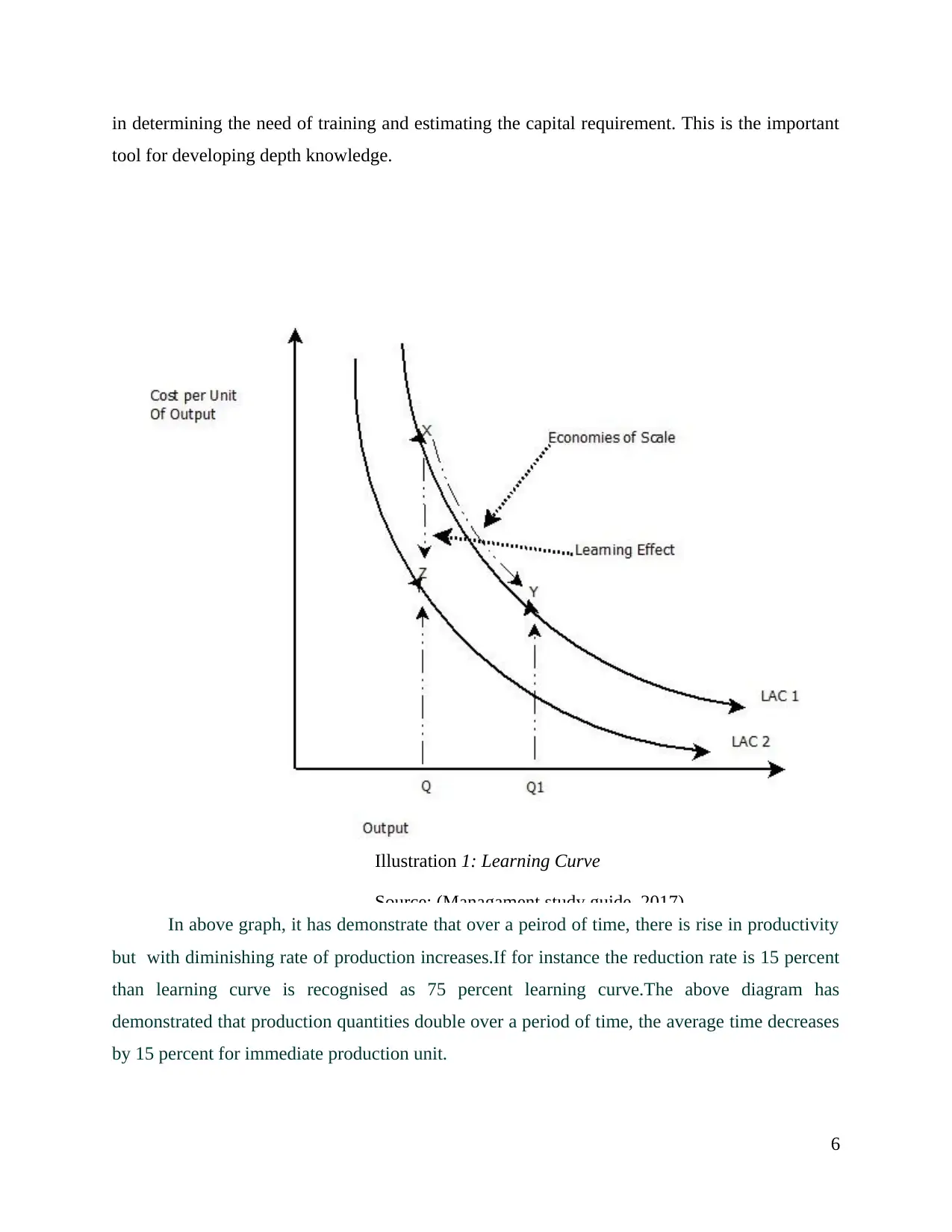
in determining the need of training and estimating the capital requirement. This is the important
tool for developing depth knowledge.
In above graph, it has demonstrate that over a peirod of time, there is rise in productivity
but with diminishing rate of production increases.If for instance the reduction rate is 15 percent
than learning curve is recognised as 75 percent learning curve.The above diagram has
demonstrated that production quantities double over a period of time, the average time decreases
by 15 percent for immediate production unit.
6
Illustration 1: Learning Curve
Source: (Managament study guide, 2017)
tool for developing depth knowledge.
In above graph, it has demonstrate that over a peirod of time, there is rise in productivity
but with diminishing rate of production increases.If for instance the reduction rate is 15 percent
than learning curve is recognised as 75 percent learning curve.The above diagram has
demonstrated that production quantities double over a period of time, the average time decreases
by 15 percent for immediate production unit.
6
Illustration 1: Learning Curve
Source: (Managament study guide, 2017)
Paraphrase This Document
Need a fresh take? Get an instant paraphrase of this document with our AI Paraphraser
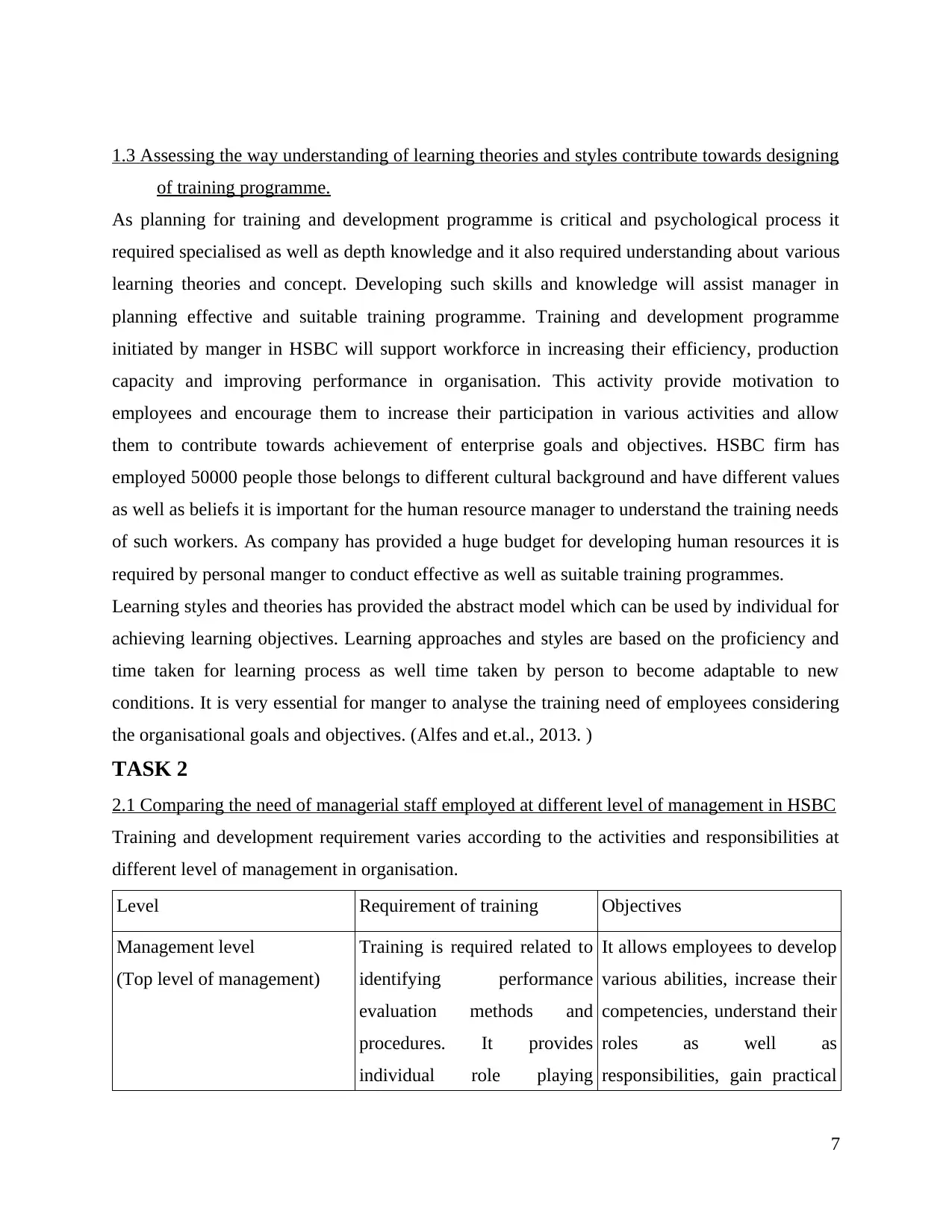
1.3 Assessing the way understanding of learning theories and styles contribute towards designing
of training programme.
As planning for training and development programme is critical and psychological process it
required specialised as well as depth knowledge and it also required understanding about various
learning theories and concept. Developing such skills and knowledge will assist manager in
planning effective and suitable training programme. Training and development programme
initiated by manger in HSBC will support workforce in increasing their efficiency, production
capacity and improving performance in organisation. This activity provide motivation to
employees and encourage them to increase their participation in various activities and allow
them to contribute towards achievement of enterprise goals and objectives. HSBC firm has
employed 50000 people those belongs to different cultural background and have different values
as well as beliefs it is important for the human resource manager to understand the training needs
of such workers. As company has provided a huge budget for developing human resources it is
required by personal manger to conduct effective as well as suitable training programmes.
Learning styles and theories has provided the abstract model which can be used by individual for
achieving learning objectives. Learning approaches and styles are based on the proficiency and
time taken for learning process as well time taken by person to become adaptable to new
conditions. It is very essential for manger to analyse the training need of employees considering
the organisational goals and objectives. (Alfes and et.al., 2013. )
TASK 2
2.1 Comparing the need of managerial staff employed at different level of management in HSBC
Training and development requirement varies according to the activities and responsibilities at
different level of management in organisation.
Level Requirement of training Objectives
Management level
(Top level of management)
Training is required related to
identifying performance
evaluation methods and
procedures. It provides
individual role playing
It allows employees to develop
various abilities, increase their
competencies, understand their
roles as well as
responsibilities, gain practical
7
of training programme.
As planning for training and development programme is critical and psychological process it
required specialised as well as depth knowledge and it also required understanding about various
learning theories and concept. Developing such skills and knowledge will assist manager in
planning effective and suitable training programme. Training and development programme
initiated by manger in HSBC will support workforce in increasing their efficiency, production
capacity and improving performance in organisation. This activity provide motivation to
employees and encourage them to increase their participation in various activities and allow
them to contribute towards achievement of enterprise goals and objectives. HSBC firm has
employed 50000 people those belongs to different cultural background and have different values
as well as beliefs it is important for the human resource manager to understand the training needs
of such workers. As company has provided a huge budget for developing human resources it is
required by personal manger to conduct effective as well as suitable training programmes.
Learning styles and theories has provided the abstract model which can be used by individual for
achieving learning objectives. Learning approaches and styles are based on the proficiency and
time taken for learning process as well time taken by person to become adaptable to new
conditions. It is very essential for manger to analyse the training need of employees considering
the organisational goals and objectives. (Alfes and et.al., 2013. )
TASK 2
2.1 Comparing the need of managerial staff employed at different level of management in HSBC
Training and development requirement varies according to the activities and responsibilities at
different level of management in organisation.
Level Requirement of training Objectives
Management level
(Top level of management)
Training is required related to
identifying performance
evaluation methods and
procedures. It provides
individual role playing
It allows employees to develop
various abilities, increase their
competencies, understand their
roles as well as
responsibilities, gain practical
7
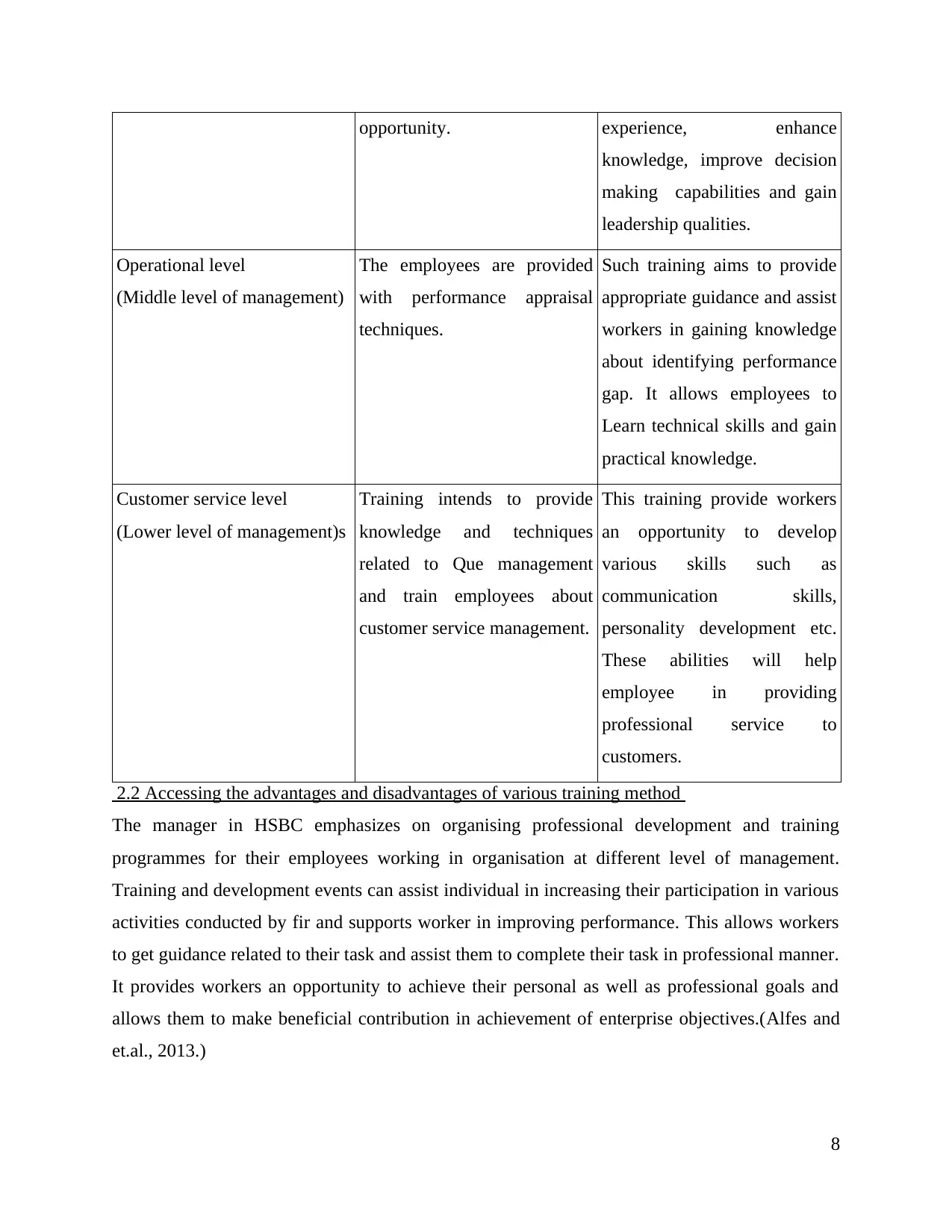
opportunity. experience, enhance
knowledge, improve decision
making capabilities and gain
leadership qualities.
Operational level
(Middle level of management)
The employees are provided
with performance appraisal
techniques.
Such training aims to provide
appropriate guidance and assist
workers in gaining knowledge
about identifying performance
gap. It allows employees to
Learn technical skills and gain
practical knowledge.
Customer service level
(Lower level of management)s
Training intends to provide
knowledge and techniques
related to Que management
and train employees about
customer service management.
This training provide workers
an opportunity to develop
various skills such as
communication skills,
personality development etc.
These abilities will help
employee in providing
professional service to
customers.
2.2 Accessing the advantages and disadvantages of various training method
The manager in HSBC emphasizes on organising professional development and training
programmes for their employees working in organisation at different level of management.
Training and development events can assist individual in increasing their participation in various
activities conducted by fir and supports worker in improving performance. This allows workers
to get guidance related to their task and assist them to complete their task in professional manner.
It provides workers an opportunity to achieve their personal as well as professional goals and
allows them to make beneficial contribution in achievement of enterprise objectives.(Alfes and
et.al., 2013.)
8
knowledge, improve decision
making capabilities and gain
leadership qualities.
Operational level
(Middle level of management)
The employees are provided
with performance appraisal
techniques.
Such training aims to provide
appropriate guidance and assist
workers in gaining knowledge
about identifying performance
gap. It allows employees to
Learn technical skills and gain
practical knowledge.
Customer service level
(Lower level of management)s
Training intends to provide
knowledge and techniques
related to Que management
and train employees about
customer service management.
This training provide workers
an opportunity to develop
various skills such as
communication skills,
personality development etc.
These abilities will help
employee in providing
professional service to
customers.
2.2 Accessing the advantages and disadvantages of various training method
The manager in HSBC emphasizes on organising professional development and training
programmes for their employees working in organisation at different level of management.
Training and development events can assist individual in increasing their participation in various
activities conducted by fir and supports worker in improving performance. This allows workers
to get guidance related to their task and assist them to complete their task in professional manner.
It provides workers an opportunity to achieve their personal as well as professional goals and
allows them to make beneficial contribution in achievement of enterprise objectives.(Alfes and
et.al., 2013.)
8
⊘ This is a preview!⊘
Do you want full access?
Subscribe today to unlock all pages.

Trusted by 1+ million students worldwide
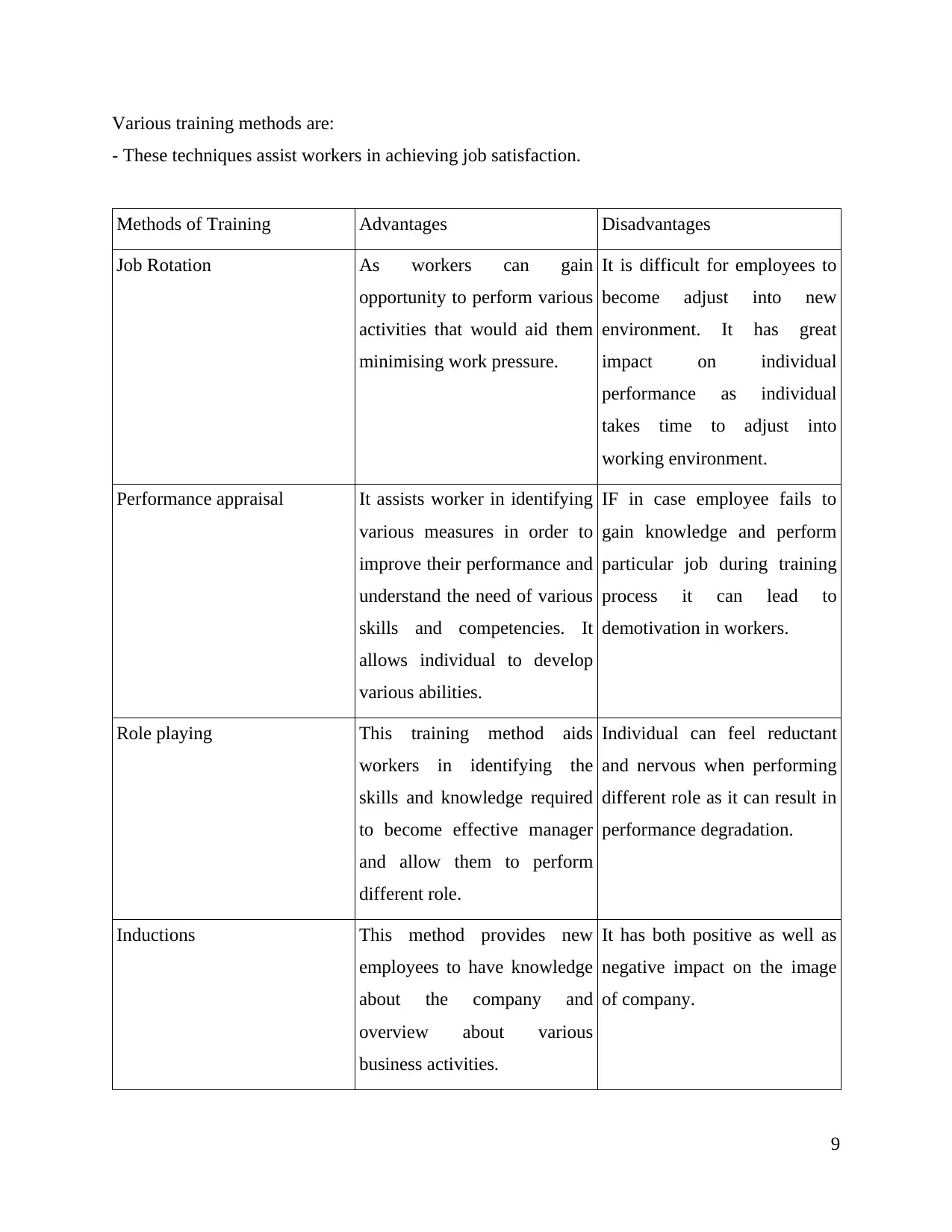
Various training methods are:
- These techniques assist workers in achieving job satisfaction.
Methods of Training Advantages Disadvantages
Job Rotation As workers can gain
opportunity to perform various
activities that would aid them
minimising work pressure.
It is difficult for employees to
become adjust into new
environment. It has great
impact on individual
performance as individual
takes time to adjust into
working environment.
Performance appraisal It assists worker in identifying
various measures in order to
improve their performance and
understand the need of various
skills and competencies. It
allows individual to develop
various abilities.
IF in case employee fails to
gain knowledge and perform
particular job during training
process it can lead to
demotivation in workers.
Role playing This training method aids
workers in identifying the
skills and knowledge required
to become effective manager
and allow them to perform
different role.
Individual can feel reductant
and nervous when performing
different role as it can result in
performance degradation.
Inductions This method provides new
employees to have knowledge
about the company and
overview about various
business activities.
It has both positive as well as
negative impact on the image
of company.
9
- These techniques assist workers in achieving job satisfaction.
Methods of Training Advantages Disadvantages
Job Rotation As workers can gain
opportunity to perform various
activities that would aid them
minimising work pressure.
It is difficult for employees to
become adjust into new
environment. It has great
impact on individual
performance as individual
takes time to adjust into
working environment.
Performance appraisal It assists worker in identifying
various measures in order to
improve their performance and
understand the need of various
skills and competencies. It
allows individual to develop
various abilities.
IF in case employee fails to
gain knowledge and perform
particular job during training
process it can lead to
demotivation in workers.
Role playing This training method aids
workers in identifying the
skills and knowledge required
to become effective manager
and allow them to perform
different role.
Individual can feel reductant
and nervous when performing
different role as it can result in
performance degradation.
Inductions This method provides new
employees to have knowledge
about the company and
overview about various
business activities.
It has both positive as well as
negative impact on the image
of company.
9
Paraphrase This Document
Need a fresh take? Get an instant paraphrase of this document with our AI Paraphraser
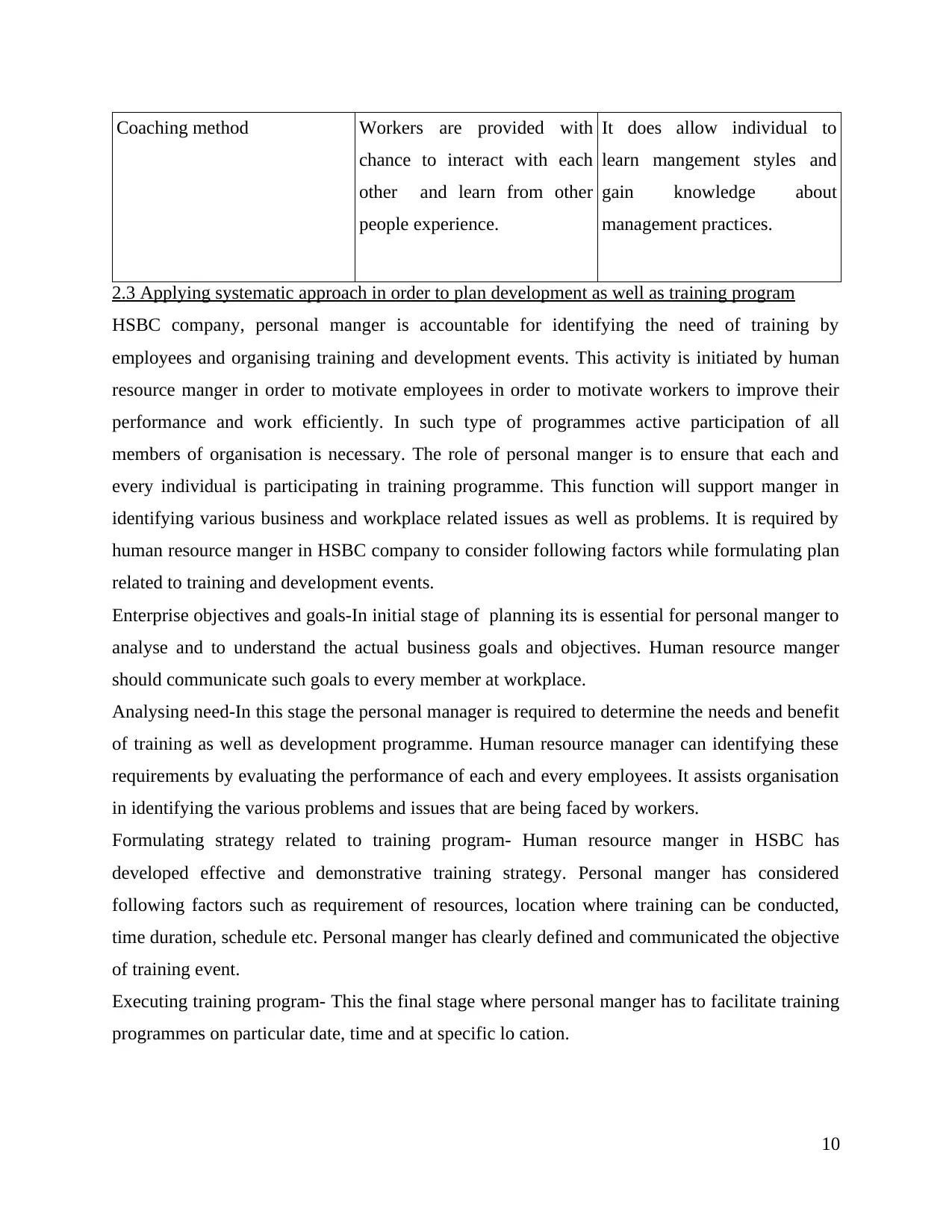
Coaching method Workers are provided with
chance to interact with each
other and learn from other
people experience.
It does allow individual to
learn mangement styles and
gain knowledge about
management practices.
2.3 Applying systematic approach in order to plan development as well as training program
HSBC company, personal manger is accountable for identifying the need of training by
employees and organising training and development events. This activity is initiated by human
resource manger in order to motivate employees in order to motivate workers to improve their
performance and work efficiently. In such type of programmes active participation of all
members of organisation is necessary. The role of personal manger is to ensure that each and
every individual is participating in training programme. This function will support manger in
identifying various business and workplace related issues as well as problems. It is required by
human resource manger in HSBC company to consider following factors while formulating plan
related to training and development events.
Enterprise objectives and goals-In initial stage of planning its is essential for personal manger to
analyse and to understand the actual business goals and objectives. Human resource manger
should communicate such goals to every member at workplace.
Analysing need-In this stage the personal manager is required to determine the needs and benefit
of training as well as development programme. Human resource manager can identifying these
requirements by evaluating the performance of each and every employees. It assists organisation
in identifying the various problems and issues that are being faced by workers.
Formulating strategy related to training program- Human resource manger in HSBC has
developed effective and demonstrative training strategy. Personal manger has considered
following factors such as requirement of resources, location where training can be conducted,
time duration, schedule etc. Personal manger has clearly defined and communicated the objective
of training event.
Executing training program- This the final stage where personal manger has to facilitate training
programmes on particular date, time and at specific lo cation.
10
chance to interact with each
other and learn from other
people experience.
It does allow individual to
learn mangement styles and
gain knowledge about
management practices.
2.3 Applying systematic approach in order to plan development as well as training program
HSBC company, personal manger is accountable for identifying the need of training by
employees and organising training and development events. This activity is initiated by human
resource manger in order to motivate employees in order to motivate workers to improve their
performance and work efficiently. In such type of programmes active participation of all
members of organisation is necessary. The role of personal manger is to ensure that each and
every individual is participating in training programme. This function will support manger in
identifying various business and workplace related issues as well as problems. It is required by
human resource manger in HSBC company to consider following factors while formulating plan
related to training and development events.
Enterprise objectives and goals-In initial stage of planning its is essential for personal manger to
analyse and to understand the actual business goals and objectives. Human resource manger
should communicate such goals to every member at workplace.
Analysing need-In this stage the personal manager is required to determine the needs and benefit
of training as well as development programme. Human resource manager can identifying these
requirements by evaluating the performance of each and every employees. It assists organisation
in identifying the various problems and issues that are being faced by workers.
Formulating strategy related to training program- Human resource manger in HSBC has
developed effective and demonstrative training strategy. Personal manger has considered
following factors such as requirement of resources, location where training can be conducted,
time duration, schedule etc. Personal manger has clearly defined and communicated the objective
of training event.
Executing training program- This the final stage where personal manger has to facilitate training
programmes on particular date, time and at specific lo cation.
10
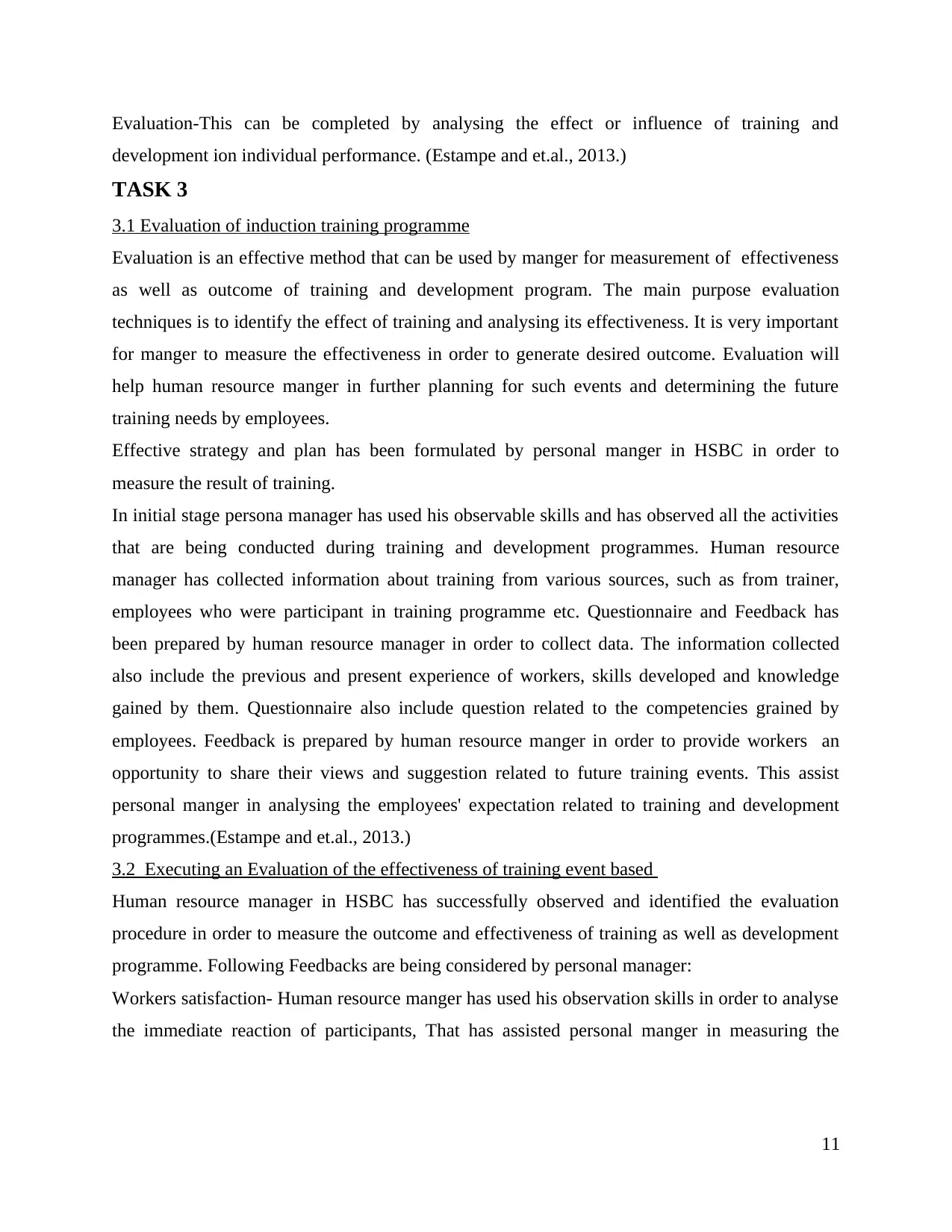
Evaluation-This can be completed by analysing the effect or influence of training and
development ion individual performance. (Estampe and et.al., 2013.)
TASK 3
3.1 Evaluation of induction training programme
Evaluation is an effective method that can be used by manger for measurement of effectiveness
as well as outcome of training and development program. The main purpose evaluation
techniques is to identify the effect of training and analysing its effectiveness. It is very important
for manger to measure the effectiveness in order to generate desired outcome. Evaluation will
help human resource manger in further planning for such events and determining the future
training needs by employees.
Effective strategy and plan has been formulated by personal manger in HSBC in order to
measure the result of training.
In initial stage persona manager has used his observable skills and has observed all the activities
that are being conducted during training and development programmes. Human resource
manager has collected information about training from various sources, such as from trainer,
employees who were participant in training programme etc. Questionnaire and Feedback has
been prepared by human resource manager in order to collect data. The information collected
also include the previous and present experience of workers, skills developed and knowledge
gained by them. Questionnaire also include question related to the competencies grained by
employees. Feedback is prepared by human resource manger in order to provide workers an
opportunity to share their views and suggestion related to future training events. This assist
personal manger in analysing the employees' expectation related to training and development
programmes.(Estampe and et.al., 2013.)
3.2 Executing an Evaluation of the effectiveness of training event based
Human resource manager in HSBC has successfully observed and identified the evaluation
procedure in order to measure the outcome and effectiveness of training as well as development
programme. Following Feedbacks are being considered by personal manager:
Workers satisfaction- Human resource manger has used his observation skills in order to analyse
the immediate reaction of participants, That has assisted personal manger in measuring the
11
development ion individual performance. (Estampe and et.al., 2013.)
TASK 3
3.1 Evaluation of induction training programme
Evaluation is an effective method that can be used by manger for measurement of effectiveness
as well as outcome of training and development program. The main purpose evaluation
techniques is to identify the effect of training and analysing its effectiveness. It is very important
for manger to measure the effectiveness in order to generate desired outcome. Evaluation will
help human resource manger in further planning for such events and determining the future
training needs by employees.
Effective strategy and plan has been formulated by personal manger in HSBC in order to
measure the result of training.
In initial stage persona manager has used his observable skills and has observed all the activities
that are being conducted during training and development programmes. Human resource
manager has collected information about training from various sources, such as from trainer,
employees who were participant in training programme etc. Questionnaire and Feedback has
been prepared by human resource manager in order to collect data. The information collected
also include the previous and present experience of workers, skills developed and knowledge
gained by them. Questionnaire also include question related to the competencies grained by
employees. Feedback is prepared by human resource manger in order to provide workers an
opportunity to share their views and suggestion related to future training events. This assist
personal manger in analysing the employees' expectation related to training and development
programmes.(Estampe and et.al., 2013.)
3.2 Executing an Evaluation of the effectiveness of training event based
Human resource manager in HSBC has successfully observed and identified the evaluation
procedure in order to measure the outcome and effectiveness of training as well as development
programme. Following Feedbacks are being considered by personal manager:
Workers satisfaction- Human resource manger has used his observation skills in order to analyse
the immediate reaction of participants, That has assisted personal manger in measuring the
11
⊘ This is a preview!⊘
Do you want full access?
Subscribe today to unlock all pages.

Trusted by 1+ million students worldwide
1 out of 18
Related Documents
Your All-in-One AI-Powered Toolkit for Academic Success.
+13062052269
info@desklib.com
Available 24*7 on WhatsApp / Email
![[object Object]](/_next/static/media/star-bottom.7253800d.svg)
Unlock your academic potential
Copyright © 2020–2025 A2Z Services. All Rights Reserved. Developed and managed by ZUCOL.





